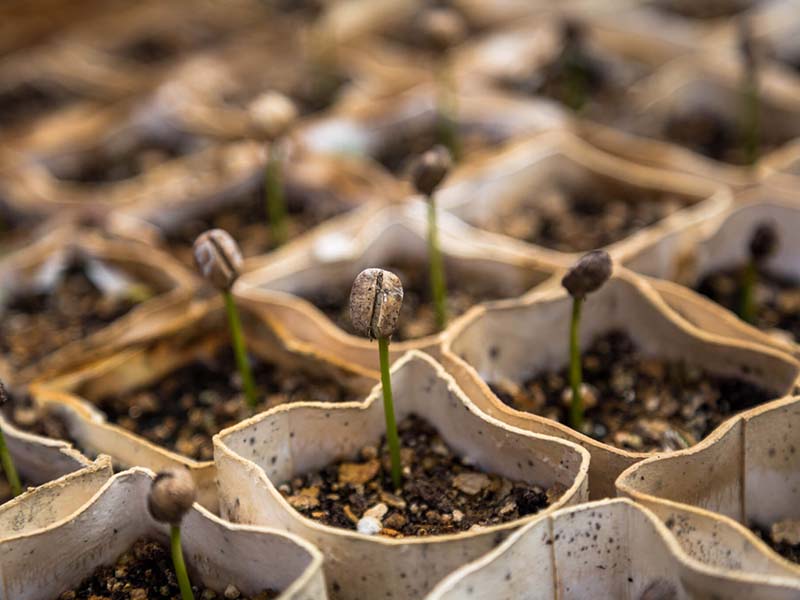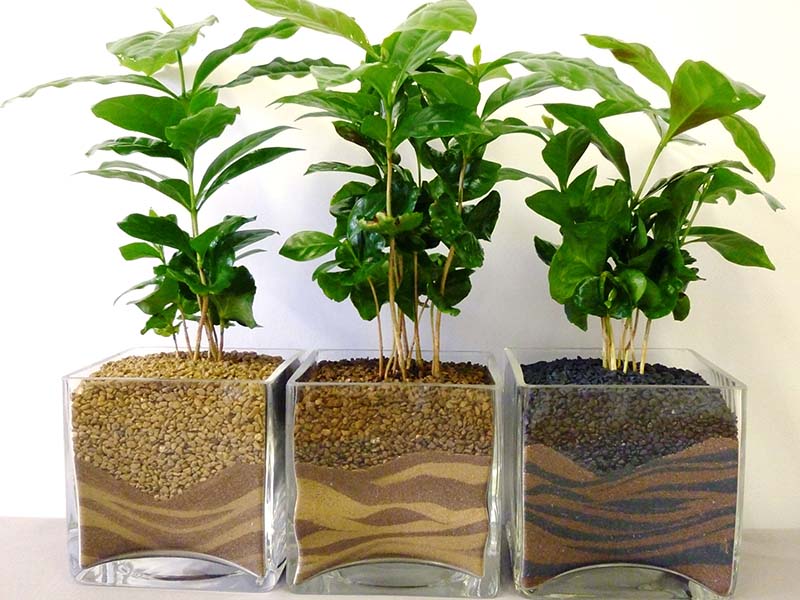Coffee, one of the biggest superstars of our culture. Coffee is a key component in the routine of a lot of people. The wake-up elixir in the mornings, the loyal companion of many moments, and a great excuse to go out, meet friends, and “go grab a coffee”. So the coffee bean is well known, the question is can you plant coffee beans? Can you grow your own coffee? Yes you can, and actually, the coffee plant makes a great house plant, it is an easy and hardy one. With a little patience and good preparation, you can grow your own coffee. Read on because today you’ll learn how to grow the coffee plant indoors and coffee plant care.
How to Grow Coffee from Seed?
The first thing you want to do when starting your homegrown coffee adventure is to choose a place for it. You can grow your plant indoors or outdoors, so depending on your housing conditions you will choose which option better suits you. If your choice is to do it inside don’t place it in an area where there is direct sunlight, this plant likes diffused sunlight better. If you decide to grow it outside you want to be aware that they grow and can become big so in order for them to grow they will need space.
If you live in an area that is not tropical and the temperature varies throughout the year, it’s best to grow the plant indoors where you can provide all that it needs. They need certain climate stability to grow well.

The next step in growing coffee plants is to find yourself seedlings, green coffee beans, or cherries. It is possible but very hard to find coffee plants already potted. Remember you want to get green seed or coffee cherries, the roasted bean will unlikely develop.
To start your potting process, the right soil will be important. You will need soil that is moist, rich in nutrients, and that gives space for the plants to grow deep. It should ideally have a pH close to 6. Another thing is that the drainage should be good, this plant doesn’t like to be swimming in water.
In order for your plant to grow beautifully and healthy you will need to care for it. Water it regularly enough to keep the soil moist, but not too much, find that sweet spot, not too wet or too dry. To keep the humidity a pebble tray with water can also be used. Every few months you can check the fertilizer for the pH level and fertilize it whenever there is a need. Pruning once in a while is also good to stimulate the growth, every spring for example. Once your plant starts growing more you will likely need to re-pot it. First when it passes the 20 cm mark, second maybe when it gets close to 60 cm. Repotting is really important for your plant, for it to thrive it will need space for its roots to grow, but if you put it inside a very large pot, a small plant, that won’t be good also.
Tips on Taking Coffee Plants Care
Sunlight Requirements
One of the most important factors in growing healthy coffee plants is ensuring that they receive the right amount of sunlight. Coffee plants typically grow best in bright, direct sunlight for most of the day. However, it is important to avoid too much direct sun, especially in the afternoon when the sun is at its hottest. This can cause the leaves to burn, reducing the overall health of the plant.
Instead, it is best to provide coffee plants with bright, indirect sunlight. This can be achieved by placing the plants in a location where they receive plenty of light, but are protected from direct sun by shade or a sheer curtain. In general, coffee plants need at least 6 hours of sunlight per day, but 8 to 10 hours is even better.
Water Requirements
Water is also a critical factor in coffee plant care. It is important to keep the soil consistently moist, but not waterlogged. To determine when to water your coffee plants, stick your finger about an inch into the soil. If the soil feels dry, it is time to water. If it feels moist, wait a few more days before checking again.
In general, coffee plants need to be watered once or twice a week, depending on the humidity and temperature in your area. When watering, it is important to provide enough water to thoroughly soak the soil, but not so much that it becomes waterlogged. Excess water can lead to root rot, which can quickly kill your coffee plants.
Soil Requirements

The soil you choose for your coffee plants is also important. Coffee plants grow best in well-drained, slightly acidic soil with a pH of 6.0 to 6.5. A rich, organic soil that contains plenty of organic matter is ideal.
It is also important to make sure that the soil has good drainage. Coffee plants do not tolerate standing water, and excess moisture can lead to root rot. To improve drainage, you can add coarse sand or perlite to the soil, or plant your coffee plants in raised beds.
Fertilizing coffee plants is also important for their growth and productivity. A slow-release, balanced fertilizer should be applied every 2 to 3 months. Avoid using fertilizer with a high nitrogen content, as this can encourage the growth of foliage at the expense of the coffee beans.
Climate Requirements
Coffee plants are tropical plants that prefer warm temperatures and high humidity levels. The ideal temperature range for coffee plants is between 60 and 70 degrees Fahrenheit. They can tolerate temperatures as low as 40 degrees, but only for short periods of time.
Humidity levels should be kept between 50% and 60%. In areas with low humidity, coffee plants can be misted regularly to help maintain proper humidity levels.
In addition to temperature and humidity, coffee plants should also be protected from strong winds. Strong winds can damage the delicate leaves and branches of the plant, and can also cause the soil to dry out more quickly. If you live in an area with strong winds, it is best to protect your coffee plants with a windbreak or by planting them in a sheltered location.
Pests and Diseases
Coffee plants can be affected by a variety of pests and diseases, including coffee berry borer, coffee leaf rust, and root rot. To prevent pests and diseases, it is important to keep your coffee plants healthy and well-maintained. This includes providing them with the proper care, such as proper sunlight, water, soil, and climate conditions, as well as pruning and fertilizing.
In the event that pests or diseases do occur, it is important to address the issue as quickly as possible. For pests, you can use organic pest control methods, such as using ladybugs to control aphids, or introducing beneficial insects such as parasitic wasps to control coffee berry borer. If you need to use chemical pesticides, be sure to follow the label instructions carefully and choose products that are safe for use on coffee plants.
For diseases, it is important to remove and destroy any infected plant parts, as well as to clean up any fallen leaves or debris. This will help to prevent the spread of the disease. You may also need to apply fungicides, following the label instructions carefully.
Pruning
Pruning is an important aspect of coffee plant care, as it promotes healthy growth and helps to maintain the size and shape of the plant. Pruning also helps to increase air flow and light penetration to the interior of the plant, which can help to prevent disease.
To prune your coffee plant, start by removing any dead or damaged branches. Then, trim back any shoots that are growing from the base of the plant, as well as any branches that are crossing or rubbing against each other. This will help to promote healthy growth and prevent disease.
It is best to prune your coffee plant during the dormant period, which typically occurs in the winter. This will help to avoid stress on the plant, and will also allow you to see the structure of the plant more clearly.
Conclusion
In conclusion, proper care is essential for healthy and productive coffee plants. By providing your coffee plants with the right amount of sunlight, water, soil, climate, and attention to pests and diseases, you can help to ensure their long-term success. Regular pruning is also important for maintaining the size and shape of the plant, as well as for promoting healthy growth and preventing disease. With proper care, your coffee plants can thrive and provide you with an abundance of delicious coffee beans for years to come.


